Physical Address
304 North Cardinal St.
Dorchester Center, MA 02124
Accurate and timely diagnosis of life-threatening disease involving the abdomen and pelvis is essential to decrease potential morbidity and mortality. Clinical evaluation is sometimes difficult, and laboratory analysis and radiographic findings are not always useful in diagnosing the condition at hand. CT imaging of the abdomen and pelvis is a reliable, highly accurate, and fast imaging diagnostic modality for the evaluation of symptomatic patients. It is most useful in patients with a clinical presentation that is unrevealing or confusing. CT allows for direct visualization of anatomic structures in the abdomen and pelvis, along with detection and characterization of the nature and extent of disease, when present.
MRI is typically used as a problem-solving diagnostic modality following initial CT or ultrasonography (US) evaluation of patients with acute symptoms or signs of abdominopelvic disease, given its longer image acquisition times and greater expense. However, it is often utilized following nondiagnostic US for the evaluation of pregnant women who present with an acute abdomen or pelvis, given its lack of ionizing radiation. Furthermore, it is being utilized more and more often as the initial diagnostic test in many nonpregnant patients who present with an acute abdomen or pelvis, given its superior soft tissue contrast resolution (even when intravenous contrast material is not administered) and lack of ionizing radiation relative to CT.
Oral contrast material distends and opacifies the bowel, allowing for better characterization of bowel pathologic conditions and separation of bowel structures from nonbowel structures. Intravenous contrast material aids in the characterization of pathologic lesions and allows for opacification and evaluation of vascular and urothelial structures. Both types of contrast material are generally administered in patients with an acute abdomen or pelvis prior to CT scanning whenever possible. In patients with a history of intravenous contrast allergy or renal insufficiency, intravenous contrast material is generally not administered, unless the patient has received a corticosteroid preparation or is scheduled to undergo dialysis after the CT examination. In patients with suspected urolithiasis, unenhanced CT without oral or intravenous contrast material is generally performed because unenhanced images are often sufficient for making a diagnosis. In patients undergoing CT angiography evaluation of the arterial vasculature, oral contrast material is generally not administered because it can obscure normal vessels and vascular pathologic conditions during multiplanar image reconstruction.
Oral contrast material is not routinely administered to patients undergoing MRI examination in the acute setting because the improved soft tissue contrast resolution allows for good visualization of the bowel wall and lumen. Intravenous gadolinium-based contrast material is routinely administered to patients undergoing MRI examination of the abdomen or pelvis in the acute setting. However, if there is a history of intravenous contrast allergy, renal insufficiency, or pregnancy, it is not administered.
This is a broad but important differential diagnosis, with representative etiologies as follows.
Inflammatory/infectious causes include acute hepatitis; acute cholecystitis; acute cholangitis; acute pancreatitis; acute pyelonephritis; peptic ulcer disease; acute infectious or inflammatory gastritis, enteritis, or colitis; acute diverticulitis; acute appendicitis; mesenteric lymphadenitis; peritonitis; epiploic appendagitis; segmental omental infarction; pelvic inflammatory disease (PID); abdominal or pelvic abscess; and Fournier gangrene.
Vascular causes include solid organ or neoplasm infarction; bowel (mesenteric) ischemia/infarction; hemorrhage (whether spontaneous or into a cyst or neoplasm); abdominal aortic aneurysm (AAA) rupture; abdominal aortic dissection or penetrating aortic ulcer; acute vascular occlusion; and adnexal torsion.
Traumatic causes include solid organ injury; hollow organ injury; and vascular injury.
Other causes include hollow organ (bowel, biliary tree, urothelial system) obstruction; bowel perforation; solid organ rupture; cyst or neoplasm rupture; abdominal compartment syndrome (ACS); and ectopic pregnancy.
An abscess is a loculated collection of pus.
On CT and MRI, an abscess appears as a complex loculated fluid collection that may contain debris, complex fluid, or hemorrhage with increased attenuation and T1-weighted signal intensity, sometimes with internal septations or very low attenuation/signal intensity gas bubbles. An abscess often has a thick enhancing rim of fibrous tissue peripherally ( Figure 32-1 ). When an abscess arises within a parenchymal organ, multiple small adjacent abscesses (i.e., “satellite lesions”) are also commonly encountered.
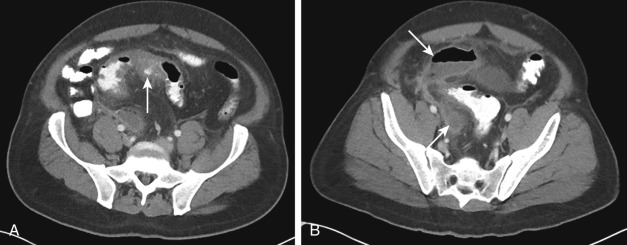
Acute appendicitis is inflammation of the appendix that occurs after luminal obstruction, and it is one of the most common causes of acute abdominopelvic pain. Patients commonly present with right lower quadrant pain and tenderness, nausea, vomiting, fever, and leukocytosis. Early and accurate diagnosis with CT or MRI helps to minimize morbidity and mortality owing to appendiceal perforation and prevents unnecessary surgery for nonsurgical conditions that may mimic the clinical presentation of appendicitis. MRI is most often utilized when acute appendicitis is suspected in the setting of pregnancy.
The most specific imaging finding is an abnormal appendix that is typically dilated to ≥ 6 mm and fluid-filled ( Figures 32-2 and 32-3 ). Visualization of a calcified appendicolith (best seen on CT) with associated periappendiceal inflammatory fat stranding or edema is also highly specific. Other imaging findings may include:
Hyperenhancement of the appendiceal wall.
Thickening of the appendiceal wall ( ≥ 3 mm), sometimes with low attenuation/high T2-weighted signal intensity submucosal edema in the wall (leading to mural stratification or a “target” sign).
Reactive thickening of adjacent cecum or small bowel.
Arrowhead-shaped funneling of the cecal apex toward the occluded appendiceal lumen (“arrowhead” sign).
A curved soft tissue structure between the cecal lumen and an appendicolith, which is representative of an inflamed cecal or appendiceal wall (“cecal bar” sign).
Periappendiceal fluid.
Thickening and enhancement of the adjacent parietal peritoneum representing focal peritonitis.
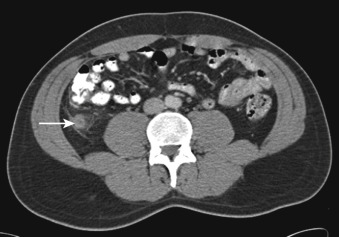
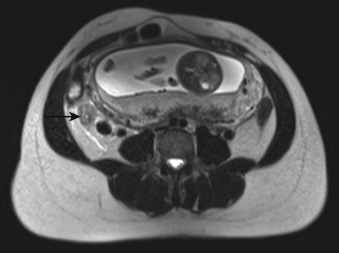
Complications include appendiceal perforation with abscess formation, small bowel obstruction, and mesenteric venous thrombosis.
In some patients, only the distal aspect of the appendix is inflamed, which is known as tip appendicitis. Therefore, the entirety of the appendix must be imaged and assessed on CT or MRI in patients with acute abdominopelvic symptoms to avoid missing this often subtle diagnosis.
Acute diverticulitis involving the large bowel is inflammation/infection in the setting of large bowel diverticulosis (i.e., the presence of multiple outpouchings of the wall of the large bowel). This condition most commonly occurs in elderly adults, most commonly (95%) in the distal descending and sigmoid colon, and much less commonly (5%) in the ascending colon and cecum. Patients present with fever, abdominal pain (often in the left lower quadrant), and leukocytosis.
CT and MRI findings include pericolic inflammatory fat stranding, thickening and enhancement of an inflamed diverticulum, inflammatory segmental wall thickening of the large bowel, pericolic gas bubbles owing to bowel microperforation, and pericolic fluid. Potential complications include abdominal or pelvic abscess formation, mesenteric or portal vein thrombosis or gas, bowel obstruction, and fistula formation between the affected large bowel segment and the bladder, vagina, small bowel, other portion of large bowel, or skin (see Figure 32-1 ).
Acute mesenteric lymphadenitis is a self-limited condition resulting from inflammation of ileal mesenteric lymph nodes, sometimes with associated terminal ileal and cecal inflammation. It often manifests with right lower quadrant pain and diarrhea and most often occurs in children and young adults. The most common causative agents include the bacteria Campylobacter jejuni and Yersinia species, although viruses may also be causative.
Characteristic CT and MRI findings include a cluster of three or more enlarged ( ≥ 5 mm) right lower quadrant mesenteric lymph nodes, sometimes with associated thickening of the cecum or terminal ileum, and a normal-appearing appendix.
PEA and segmental omental infarction are self-limited conditions that often manifest with focal severe acute abdominal pain and tenderness and are treated with conservative therapy (e.g., analgesics). PEA is related to torsion, inflammation, and ischemia of an epiploic appendage, and segmental omental infarction is related to spontaneous infarction of a portion of the omentum.
CT and MRI findings of PEA include a small (1 to 5 cm) round or oval pedunculated fat attenuation/signal intensity structure with a soft tissue enhancing rim located adjacent to the serosal surface of the large bowel (in the expected location of an epiploic appendage), commonly with a high attenuation/low signal intensity central dot or line from thrombosis of a central vein or fibrosis. Associated inflammatory fat stranding and reactive bowel wall or peritoneal thickening may also be seen ( Figure 32-4 ). PEA occurs most commonly adjacent to the sigmoid colon.
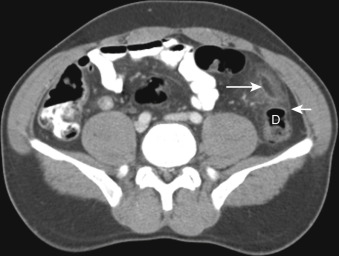
CT and MRI findings of segmental omental infarction include a large (5 to 10 cm) well-circumscribed focus of fat attenuation/signal intensity with associated inflammatory fat stranding. Typically, the infarction is located in the right anterolateral aspect of the abdomen between the colon and parietal peritoneum at or above the umbilical level (in the expected location of the greater omentum).
Acute cholecystitis is inflammation of the gallbladder wall owing to obstruction of the cystic duct or gallbladder neck. This is most often caused by gallstones (calculous cholecystitis), although in 5% to 10% of cases, gallstones are not present (acalculous cholecystitis). Acalculous cholecystitis tends to occur in the setting of prolonged illness, such as with prior traumatic or burn injury or with a prolonged intensive care unit stay. Most patients present with right upper quadrant pain and tenderness (Murphy sign), although in the setting of severe advanced inflammation, diabetes mellitus, or elderly age, these clinical findings may be less severe or absent. Treatment generally involves cholecystectomy (or percutaneous cholecystostomy for patients at high surgical risk) along with antimicrobial therapy.
CT and MRI findings include smooth or irregular gallbladder wall thickening, generally ≥ 4 mm in thickness (sometimes with decreased attenuation/high T2-weighted signal intensity because of edema); gallbladder distention (>5 cm in width); pericholecystic inflammatory fat stranding or fluid; gallstones or gallbladder sludge; increased gallbladder wall enhancement; and transiently increased late arterial phase enhancement of the adjacent liver parenchyma owing to the inflammatory process ( Figure 32-5 ). Both CT and MRI have high sensitivity and specificity for the diagnosis of acute cholecystitis. Note that only ≈75% of gallstones are detected on CT, whereas >95% are visualized on MRI.
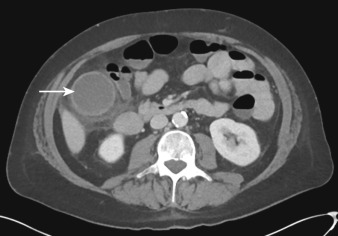
Gangrenous cholecystitis is a severe, advanced form of acute cholecystitis with ischemic necrosis of the gallbladder wall, which is associated with a higher rate of gallbladder perforation. This cholecystitis occurs more commonly in elderly men and in individuals with preexisting cardiovascular disease.
CT and MRI findings include marked gallbladder wall thickening and distention; intraluminal membranes; intraluminal hemorrhage; irregularity or absence of the gallbladder wall; and lack of gallbladder wall enhancement. Gas may also sometimes be seen within the gallbladder wall or lumen, and a pericholecystic abscess may be seen with gallbladder perforation.
Become a Clinical Tree membership for Full access and enjoy Unlimited articles
If you are a member. Log in here